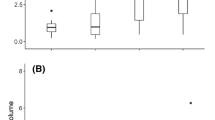Abstract.
Nest structure in ants is often designed to optimize the colony’s ability to thermoregulate, and this specialization is most highly developed in mound-building ant species. Solenopsis invicta invest a large amount of energy in building mounds and transporting their brood up and down in their nests as a means of thermoregulation. Because few ant species build true mounds, we wanted to determine the effectiveness of these mounds in harvesting solar heat as well as to distinguish what factors (temperature vs. circadian rhythm) govern where fire ants place their brood in the mound and when they place it. We measured temperature patterns in the mound over several days at different depths and under different conditions (under direct sunlight or shade), and then conducted a series of field experiments to manipulate the orientation and time of heating.
On cool mornings in spring or fall, surface temperatures of the mound rise at the fastest rate on the side receiving the most direct sunlight (usually the south side). This heating causes a temperature gradient through different depths in the mound, and shows little difference from outside ground temperature at a depth greater than ~40 cm inside the nest. In the morning, fire ants move their brood up into the mound on the side most directly heated, and when temperatures exceed optimal (~32°C) they move their brood down the temperature gradient to lower depths in the nest. In addition to this, mound temperature does not only increase due to direct sunlight, but temperature also increases higher than ground temperatures when the mound is in the shade due to its low specific heat.
Experiments in which sunlight was mirrored to the normally shaded side of the mound, or when mounds were heated at night, revealed that S. invicta primarily track temperature patterns and do not rely on behavioral habits or circadian rhythms for the thermoregulatory transport of their brood. When mounds were shaded, S. invicta brood was evenly distributed directly under the surface of the mound rather than aggregating towards a specific side. The fire ant mound is important for thermoregulation because, compared to moundless subterranean nests, it absorbs heat more rapidly both in direct sunlight and shady conditions. Temperature tracking within the nest is key to understanding thermoregulatory placement of fire ant brood, as well as insight into the production of sexual brood and reproduction.
Similar content being viewed by others
Author information
Authors and Affiliations
Corresponding author
Additional information
Received 9 August 2007; revised 31 January 2008; accepted 7 February 2008.
Rights and permissions
About this article
Cite this article
Penick, C.A., Tschinkel, W.R. Thermoregulatory brood transport in the fire ant, Solenopsis invicta . Insect. Soc. 55, 176–182 (2008). https://doi.org/10.1007/s00040-008-0987-4
Published:
Issue Date:
DOI: https://doi.org/10.1007/s00040-008-0987-4




